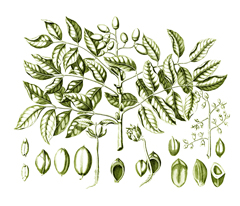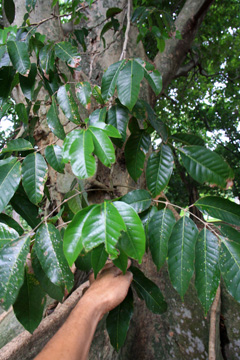 |
|
https://edibleplants.org/ |
 |
| Ahmad Fuad Morad flickr |
Translate this page:
Summary
Java Almond, Canarium vulgare, is a tropical, deciduous, fast-growing tree that functions as food tree, shade tree, and ornamental tree. It grows up to 45 m high and its crooked bole can reach up to 150 cm wide. It is found in Southeast Asia. The leaves are oblong and have papery texture. The flowers form a cluster at the end of branches. The seed of C vulgare is consumed raw or cooked. It has a rich, pleasant flavour and is used as a substitute to common almond. It can also be ground into a powder and used to make bread. It also yields edible oil which can also be used as an illuminant. The resin is used for varnish and caulking boats. The wood is soft and mainly used for fuel.
Found In: Asia, Cook Islands, East Timor, Fiji, Hawaii, Indonesia, Malaysia, Pacific, Papua New Guinea, PNG, Ponape, Philippines, SE Asia, Solomon Islands, Sri Lanka, Timor-Leste, USA, Vanuatu. Other Names: Chinese-olive, Kenari nut-tree, Gisau.
Physical Characteristics

 Canarium vulgare is a deciduous Tree growing to 45 m (147ft) by 30 m (98ft) at a fast rate.
Canarium vulgare is a deciduous Tree growing to 45 m (147ft) by 30 m (98ft) at a fast rate.
See above for USDA hardiness. It is hardy to UK zone 10. The flowers are pollinated by Insects.
Suitable for: light (sandy), medium (loamy) and heavy (clay) soils and prefers well-drained soil. Suitable pH: mildly acid, neutral and basic (mildly alkaline) soils. It cannot grow in the shade. It prefers moist soil.
UK Hardiness Map
US Hardiness Map
Synonyms
Canarium commune Auct.
Plant Habitats
Edible Uses
Edible Parts: Oil Seed
Edible Uses: Oil
Seed - raw or cooked[ 63 , 301 ]. A rich, pleasant flavour, it is highly favoured as a snack[ 301 , 303 , 451 ]. Used as a substitute for the common almond, it is somewhat sweeter in flavour[ 63 ]. It can be ground into a powder and used to make bread[ 301 ]. The seeds are used in a wide variety of dishes by the local people[ 63 ]. The seed contains about 72% oil, 13% protein and 7% starch[ 63 ]. It has been found that adding a strained emulsion of the crushed, well-ripened kernels to cows milk makes it much more digestible if fed to babies[ 63 ]. An edible oil is obtained from the seed[ 301 ]. It is preferred to coconut oil by local people[ 63 ].
References More on Edible Uses
Medicinal Uses
Plants For A Future can not take any responsibility for any adverse effects from the use of plants. Always seek advice from a professional before using a plant medicinally.
Balsamic
The resin is used medicinally as a balsam[ 303 ].
References More on Medicinal Uses
The Bookshop: Edible Plant Books
Our Latest books on Perennial Plants For Food Forests and Permaculture Gardens in paperback or digital formats.

Edible Tropical Plants
Food Forest Plants for Hotter Conditions: 250+ Plants For Tropical Food Forests & Permaculture Gardens.
More

Edible Temperate Plants
Plants for Your Food Forest: 500 Plants for Temperate Food Forests & Permaculture Gardens.
More

More Books
PFAF have eight books available in paperback and digital formats. Browse the shop for more information.
Shop Now
Other Uses
Containers Fuel Furniture Oil Varnish Waterproofing Wood
Other uses rating: Medium (3/5). Agroforestry Uses: The tree is grown in nutmeg groves in order to provide shade and shelter[ 63 , 451 ]. Other Uses The oil from the seed is used as an illuminant[ 63 ]. The resin is suitable for varnish and caulking boats[ 303 ]. It is not produced abundantly[ 451 ]. The hard, even-textured shells are well adapted to carving and are made into fancy articles of various kinds[ 63 ]. The wood is rather soft[ 451 ]. It is used for making canoes. Paddles have been manufactured from the buttresses[ 303 ]. The wood is mainly used for fuel[ 451 ]. This species is one of the sources of kedondong timber, which is obtained from several species in the family Burseraceae[ 303 ]. We do not have a specific description of the wood for this species, but the general description of kedondong wood is as follows:- The heartwood is generally a light brown; it is not sharply demarcated from the 3 - 5cm wide band of lighter-coloured sapwood. The texture is moderately fine and even; the grain is interlocked to wavy; the surface is lustrous. The wood is light in weight; moderately hard; not very durable, being susceptible to fungi, dry wood borers and termites. It seasons somewhat slowly with only a slight risk of checking and distortion; once dry it is moderately stable to stable in service. The wood has a fairly high blunting effect, stellite-tipped and tungsten carbide tools are recommended; it is moderately easy to slightly difficult to plane; finishes smooth to rough; can be easy to very difficult to bore; slightly difficult to difficult to turn; nailing and screwing properties are good; gluing is correct. The wood is suitable for internal use as a general utility timber for planking, cladding, plywood, flooring, furniture, packing cases, pallets and general carpentry work[ 316 , 848 ].
Special Uses
Food Forest
References More on Other Uses
Cultivation details
A tree of the lowland tropics, succeeding at elevations up to 1,200 metres[ 303 ]. Seedling trees begin to bear crops of seeds when about 6 - 8 years old[ 307 ]. Wild forms usually have three, sometimes two kernels present in the nut, each in its own compartment[ 63 ]. In the case of cultivated trees, however, only one kernel may be present in each nut[ 63 ]. When this is so, the kernel is proportionately larger and the nut easier to crack[ 63 ]. The seeds can vary considerably in shape and quality from tree to tree[ 63 ]. Flowering and fruiting can occur throughout the year[ 303 ].
References Carbon Farming Information and Carbon Sequestration Information
Temperature Converter
Type a value in the Celsius field to convert the value to Fahrenheit:
Fahrenheit:
The PFAF Bookshop
Plants For A Future have a number of books available in paperback and digital form. Book titles include Edible Plants, Edible Perennials, Edible Trees,Edible Shrubs, Woodland Gardening, and Temperate Food Forest Plants. Our new book is Food Forest Plants For Hotter Conditions (Tropical and Sub-Tropical).
Shop Now
Plant Propagation
Seed - it has a hard seed coat and germinates erratically. Filing away some of the seed coat to allow moisture to enter more readily, without damaging the seed, will encourage a faster and more even germination[ 658 ]. Treated seed generally has about 85% viability[ 303 ]. Air-dry seed can be stored without temperature control for several months up to 1.5 years, without losing its viability.
Other Names
If available other names are mentioned here
Java Almond, Canarium vulgare. Other Names: Chinese-olive, Kenari nut-tree, Gisau.
Native Range
TROPICAL ASIA: New Guinea, Indonesia, Sulawesi, Jawa (Kangean Islands & Bawean Islands), Lesser Sunda Islands, Maluku,
Weed Potential
Right plant wrong place. We are currently updating this section.
Please note that a plant may be invasive in one area but may not in your area so it's worth checking.
None Known
Conservation Status
IUCN Red List of Threatened Plants Status : This taxon has not yet been assessed

Growth: S = slow M = medium F = fast. Soil: L = light (sandy) M = medium H = heavy (clay). pH: A = acid N = neutral B = basic (alkaline). Shade: F = full shade S = semi-shade N = no shade. Moisture: D = dry M = Moist We = wet Wa = water.
Now available:
Food Forest Plants for Mediterranean Conditions
350+ Perennial Plants For Mediterranean and Drier Food Forests and Permaculture Gardens.
[Paperback and eBook]
This is the third in Plants For A Future's series of plant guides for food forests tailored to
specific climate zones. Following volumes on temperate and tropical ecosystems, this book focuses
on species suited to Mediterranean conditions—regions with hot, dry summers and cool, wet winters,
often facing the added challenge of climate change.
Read More
Expert comment
Author
Leenh.
Botanical References
Links / References
For a list of references used on this page please go here
A special thanks to Ken Fern for some of the information used on this page.
Readers comment
| Add a comment |
|
If you have important information about this plant that may help other users please add a comment or link below. Only comments or links that are felt to be directly relevant to a plant will be included. If you think a comment/link or information contained on this page is inaccurate or misleading we would welcome your feedback at [email protected]. If you have questions about a plant please use the Forum on this website as we do not have the resources to answer questions ourselves.
* Please note: the comments by website users are not necessarily those held by PFAF and may give misleading or inaccurate information.
To leave a comment please Register or login here All comments need to be approved so will not appear immediately.
|
Subject : Canarium vulgare
|
|
|
|